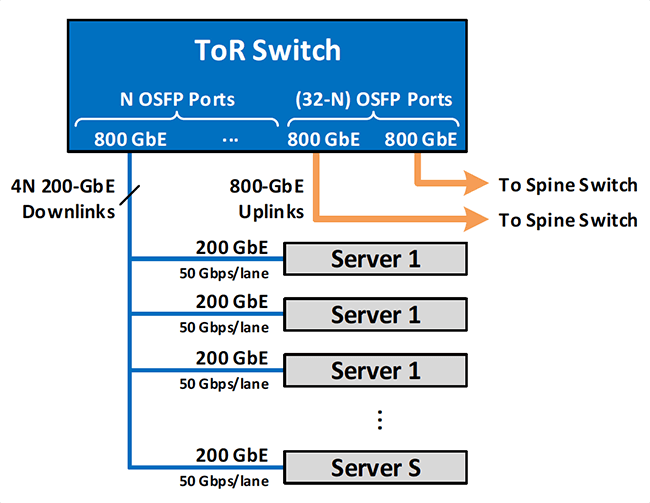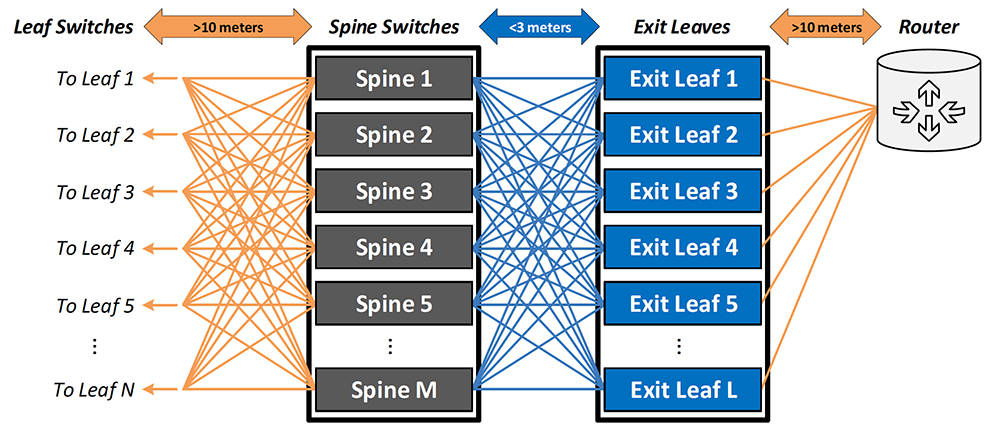New challenges arise for cabling complexity, serviceability, and rack power
As new compute-intensive machine learning (ML) and artificial intelligence (AI) workloads drive servers to adopt faster PCI-Express® 5.0 Links, lower-latency cache-coherent protocols like Compute Express Link®(CXL®), and a dizzying array of memory, storage, AI processor (AIP), smart NIC, FPGA, and GPU elements, so too is heterogeneous computing pushing the need for blazing-fast networks to interconnect the resources. Distributed compute/memory/storage nodes have spawned requirements for a high-bandwidth, low-latency, and-perhaps most importantly-scalable and serviceable network topology, one which can support the explosion of “east-west” traffic brought about by resource disaggregation.
Data Center Interconnects Transition to 400/800-GbE Ports
100 GbE, based on 25 Gbps/lane technology, is the workhorse of today’s hyperscale datacenter Ethernet networks: connecting servers and storage to leaf switches, and leaf switches to spine switches. In a Clos network topology—common in hyperscale datacenters—scale is achieved by adding more servers under a new leaf switch and connecting this leaf switch to all next-level spine switches (Figure 1). Likewise, bandwidth may be scaled by adding additional spine switches (Figure 2).


An obvious bottleneck for both the latency of the network (how many “hops” from server to server) as well as the bandwidth of the network segments (port speed) is the leaf and spine switch-often the same physical piece of equipment. Switch silicon providers have been working hard on both fronts: increasing I/O speeds to 50 Gbps/lane today and moving to 100 Gbps/lane in 2021; and increasing the number of ports (the “radix”) to 64 eight-lane ports (e.g., QSFP-DD or OSFP form factors). All told, this amounts to 25.6 Tbps of switching bandwidth, which is helping to enable faster and flatter network topologies based on 400-GbE and 800-GbE ports.
To further enable the full usage of 400-GbE and 800-GbE ports while lowering the overall TCO, we have developed the Taurus Smart Cable Module™ (Taurus SCM™).
1. Challenges for Switch-to-Server and Switch-to-Switch Interconnectors
1.1 Switch-to-Server Interconnect Challenges
With an increase in port speed and port count comes new challenges for these lowest layers in the data center network. The first key challenge is how do you effectively distribute switch port bandwidth to servers? Server network interface cards (NICs) lag switch ports in terms of bandwidth. While 400-GbE switch ports came to market in 2020, server NIC ports are generally at 200-GbE or less. More fundamentally, there is a disparity between per-lane speed of server NIC ports and switch ports. While switch ports now run at 50 Gbps/lane, NIC ports are (for the most part) still at 25 Gbps/lane. When 100 Gbps/lane switch ports arrive in 2021, NIC ports will just be making the transition to 50 Gbps/lane. There is a price to pay for connecting a switch directly to a NIC: switch port bandwidth is underutilized, by a factor of two! Resolving this disparity requires rate conversion on the NIC side up to the higher 100 Gbps/lane speed to fully-utilize the switch port bandwidth.
The most abundant (and cost-sensitive) interconnect in the data center is the top-of-rack (ToR) switch to server interconnect. Painstaking efforts are made to keep this interface low-cost and easy-to-maintain. As such, passive direct attached copper (DAC) cables are traditionally used for these 1-3 meter links. As ToR switch ports move to 100 Gbps/lane, such reach becomes questionable and cable thickness, bend radius, and weight become a concern.

Challenges for 400/800-GbE Switch-to-Server Interconnects
- Rate mismatch between NIC (25 or 50 Gbps/lane) and switch (50 or 100 Gbps/lane) leads to wasted switch bandwidth.
- Traditional DAC interconnect becomes too short, thick, and bulky, especially when using one ToR for a grouping of 2-3 racks.
1.2 Switch-to-Switch Interconnect Challenges
The second key challenge is how do you connect 400/800-GbE switch ports to one another in a practical manner? A simple Clos network topology connects every leaf switch to every spine switch; and in turn, every spine switch is connected to some number “exit leaf” switches (at least two), as shown in Figure 4.


The leaf and spine switches are generally not co-located (i.e., >10 meters apart). For example, the leaf switches may be at the top (or middle) or each server rack, whereas the spine switches may be at the end of a row or a cluster of rows. The spine switches, on the other hand, are often co-located (i.e., <3 meters apart), as shown in Figure 4.
Spine-to-exit-leaf interconnects (3 meters or less) can be serviced by copper cables, but they are not without their challenges.
Challenges for 400/800-GbE Copper Interconnects
- At 50 Gbps/lane, passive direct-attach copper (DAC) cables barely meet the 3-meter reach requirement.
- At 100 Gbps/lane, experts predict 2 meters may be the practical limit for DACs.
- The switch PCB consumes too much of the overall 35-dB end-to-end channel budget, greatly limiting cable reach and increasing diameter.
- DACs are too rigid, heavy, and bulky. They restrict airflow and make servicing the rack practically impossible.
- At 26 AWG and 16 twinax pairs per cable, there simply is not enough room to achieve a reliable cable attach in the narrower QSFP-DD form factor. OSFP may be the only option.
Challenges for 400/800-GbE Optical Interconnects
- Power consumption of 400-GbE modules is ~12 W, and this is expected to balloon to ~20 W for 800-GbE modules.
- Optical modules require a “short reach” interface to the host switch ASIC and designing such an interface to support 100 Gbps/lane speeds is costly, again requiring exotic PCB materials or mid-board cables, both of which can add significant cost and reliability concerns to a system design.
- The lifespan and reliability of optical modules is historically unimpressive, which means data center operators are constantly having to track down, diagnose, and replace failed modules.
- Industry experts question whether low-cost “VCSEL-based” optics will be possible for 800-GbE.
2. Practical Solutions to Switch-to-Server and Switch-to-switch Interconnects
Various solutions have been proposed to these challenges – some in use already for 50 Gbps/lane, and many expected to be adopted for 100 Gbps/lane.
Solutions to 400/800-GbE Switch-to-Server Interconnect Challenges
- General-purpose active electrical cables (AECs) can be used to perform rate conversion and achieve a much thinner diameter cable compared to passive DACs. However, they lack the advanced cable and fleet management features essential to support managed hyperscale data center infrastructure.
- Smart Electrical Cables (SECs) with Taurus SCMs provide all the benefits of a general-purpose AEC while also offering built-in end-to-end security, and advanced cable and fleet management capabilities. Additionally, Taurus SCMs enable a flexible supply chain of SECs by qualifying with leading cable vendors to support purpose-built management features in QSFP-DD and OSFP backshells.
Solutions to Switch-to-Switch Copper Interconnect Challenges
- General-purpose AECs may be used to achieve longer, thinner cables-with a side benefit of relaxing the design requirements of the switch PCB (i.e., the switch may be designed for “short reach” instead of “long reach” channels). That said, they again fall short in providing deep system visibility and diagnostic features that are required for today’s hyperscale data centers.
- SECs with Taurus SCMs provide a thin, flexible cable gauge, higher-reliability and lower-power profiles while also offering cloud service providers system-wide visibility and management features that enable enhanced security options, quick debug tools, and flexible firmware upgrade capabilities. Furthermore, Taurus SCMs are the only connectivity solution available today that can achieve 800-GbE performance, where competing AECs are still limited to 400-GbE.
Conclusions
While heterogeneous computing trends have led to the cramming of more processing power and bandwidth into servers and other end-node boxes, these same trends have resulted in an explosion in “east-west” traffic: data moving between servers, GPU trays, storage, and other end-node systems in the network. Luckily, 100 Gbps/lane technology will help carry this increased bandwidth; but with it comes new interconnect challenges and bottlenecks in switch-to-switch and switch-to-server connectivity. Smart Electrical Cables with Taurus Smart Cable Modules help remove these bottlenecks and offer built-in advanced cable and fleet management capabilities critical to ensuring high reliability and system up-time. Additionally, as a Smart Cable Module, Taurus can be designed into any cable OEM’s higher bandwidth copper Ethernet cable solution, which support a flexible supply chain of “active” plus “smart” cables for hyperscalers that will be key to supporting a new age for intelligent networks.